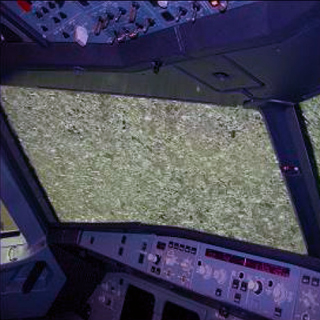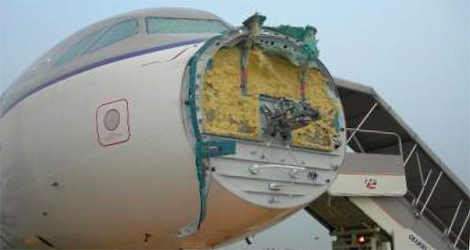On June 9, 2006, about 17:40, Asiana Airlines flight OZ8942 , an Airbus 321-100 (Registration HL7594), enroute from Jeju Airport to Gimpo Airport, encountered a thunderstorm accompanied by hailstones around 20 miles southeast of Anyang VOR at an altitude of 11,500 ft during descending to approach Gimpo Airport.
Asiana Airlines flight OZ8942 was a regularly scheduled domestic passenger service flight operating under instrument flight rules (IFR).

Asiana Airlines – Airbus – A321-100 (HL-7594) flight OZ8942
At the time of the accident, one captain, one first officer, 4 cabin crew and 200 passengers were on board, and no one sustained injuries while the radome in the nose section of the aircraft was detached and the cockpit windshield was cracked.
On the day of the accident, the flight crew were scheduled for two round-trip flights between Gimpo and Jeju Airports departing from Gimpo Airport at 11:50.
And at the time of the accident, the aircraft was on the final leg to Gimpo Airport after departing from Jeju Airport about 17:05. According to the radar track and Cockpit Voice Recorder recordings, when Asiana Airlines flight OZ8942 was flying along route B5763 to Gimpo Airport after taking off from Jeju Airport, at 17:30:53, the controller in ATC Air Traffic Center instructed flight 8942 to fly heading 040 ° for the separation from the other aircraft around 30 NM south of NUMNDA, and at 17:32:08, instructed the flight to fly directly to NUMNDA in order to reenter route B576.
At 17:33:05, the flight crew requested heading 030 ° to avoid clouds during a turn to NUMDA, and the controller gave permission.
At 17:34:04, immediately after the flight crew requested the controller of Air Traffic Center for the further descent from an altitude of 16,000 ft, the Air Traffic Center controller transferred the control of flight OZ8942 to Seoul Approach Control, and the Seoul Approach Control controller gave permission to descend to an altitude to 11,000 ft.
At 17:36:02, the flight crew requested high speed descent, and the controller permitted it.
In the meantime, the speed of Asiana Airlines flight OZ8942 reached up to about 325 knots at 17:37:09.
At 17:38:33, Asiana Airlines flight OZ8942 started to shake as it was passing through an area at an altitude of about 13,000 ft, and the cabin crew announced to check passenger seat belts fastened.
At 17:38:42, the captain instructed the first officer to request for a left-turn, and at 17:38:48, the first officer requested the left-turn to the controller (“Seoul Approach, AAR8942 request left Turn”).
At 17:39:26, flight 8942 was given permission to turn left to 330 °, and during the turn, it encountered with a hailstorm for 36 seconds from 17:40:02 until 17:40:38. After the encounter with the hailstorm, the radome located in the front section of the aircraft was detached, and the surface of windshield was cracked to the extent that the flight crew were not able to discern the foreview.
In addition, Auto Thrust System, Auto Pilot System and Flight Director System were disconnected.
The flight crew of Asiana Airlines flight OZ8942 manually attempted to approach and land on runway 14R of Gimpo Airport twice following the radar vectoring of the approach controller, but went around due to its difficulty in safe landing.
About 18:13, they made a successful and safe landing on the third approach attempt.
The flight route selected by the flight 8942 crew in order to avoid the thunderstorm was not separated enough by distance from the thunderstorm, and the alertness to the thunderstorm paid by the flight crew during descending was not sufficient, and the flight direction chosen when in close proximity to the thunderstorm was not appropriate to avoid the thunderstorm.
- Asiana Airlines flight OZ8942 was maintaining high descending speed when encountered with the thunderstorm.
- The speed of Asiana Airlines flight OZ8942 was increased to 346 knots almost close to the maximum operating speed (350 knots) after disconnection of auto thrust and autopilot systems.
- The noise generated after the detachment of radome seriously hindered conversations between the flight crew and the communication between the flight crew and the approach control.
- The cracked cockpit windshield seriously impeded the flight crew from having visual contact with the runway and making a landing.
- The disconnection of auto thrust, autopilot and fight director systems seriously impeded the flight crew from making a stable landing.
- Asiana Airlines did not use the weather forecast or SIGMET information officially dispatched by Aviation Meteorological Office through AFTN by means of having them input in the FMC, instead obtained the necessary weather information including weather forecast by means of logging into the weather information system provided additionally by Aviation Meteorological Office.
- SIGMET information was not announced by Aviation Meteorological Office although it existed between 16:30 and 18:30 on the day of accident.
- It is stipulated in a relevant agreement that the weather forecaster of Aviation Meteorological Office should conduct a weather briefing to the Air Traffic Center controllers, however, on the day of accident, the briefing was not conducted to the group of the controllers on duty who provided the ATC services to Asiana Airlines flight OZ8942.
- The controllers of Seoul Approach Control could not receive directly in their control seats SIGMET information officially provided by Aviation Meteorological Office, instead, they used a system of obtaining weather information by logging into the weather information system provided additionally by Aviation Meteorological Office, which was insufficient to receive on time the weather forecast or SIGMET information announced at irregular hours.
- Under the weather condition of visibility of 5 miles or less in Gimpo Airport, the airport lightings were switched on by the Gimpo Tower controller 14 minutes after the controller was aware of the emergency landing declared by Asiana Airlines flight OZ8942, the timing of which was inappropriate.
- Air traffic control and Seoul approach control were not operation the broadcasting system on the SIGMET information for the aircraft flying in their control areas.
Download Report


0 Comments